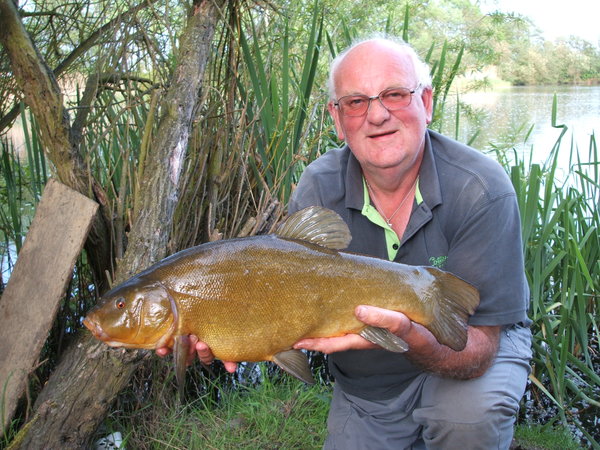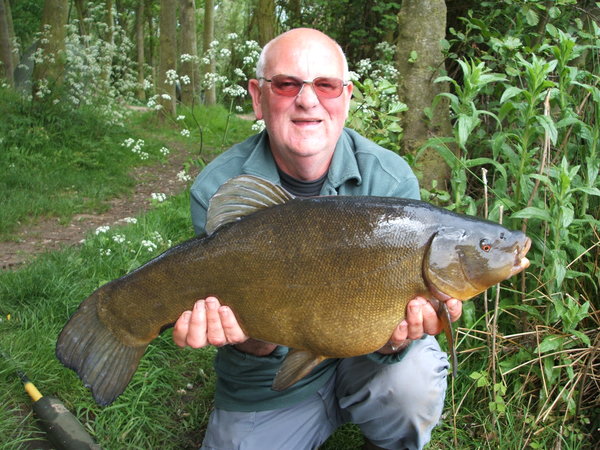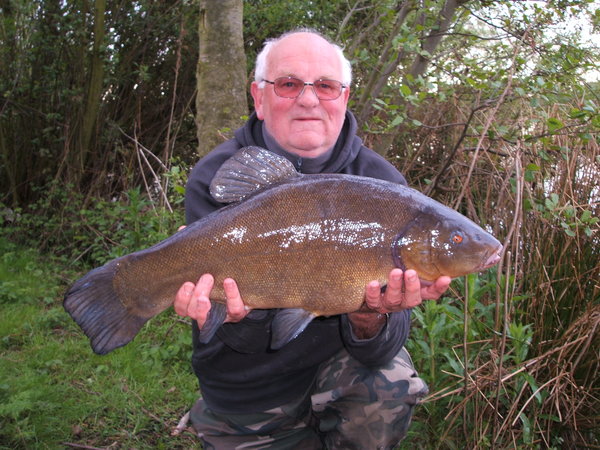During my tench fishing trips in 2010 I found that I was “dropping” more tench than was acceptable. We all have a fish “drop off” the hook now and again but I wanted to make more of the chances I was getting and get a few more of those tench on the bank. I have to say that other anglers fishing the same lake were also experiencing ‘dropped’ fish so I wasn’t the only one suffering this problem.
On one particular trip in late April I arrived early in the morning (I only fished daytime – no nights) and was fishing by 6.15am.
At 7.05 I had my first tench in the net, a nice fish of 8lb 15oz. This was soon followed by a 6lber, and at 7.55 I had a very good fish weighing 9lb 12oz. I then had a ‘toddler’ 5lber followed by a beauty of 10lb 1oz. This was followed by another two ‘toddlers’ and then at 10.30 I had my second double weighing 10lb 7oz.
I fished on until 6.25pm and caught another 9 tench, two nines (best 9lb 12oz), 1 eight, 2 sevens, and 4 sixes.

9lb on the nose
A total of 17 tench, two of which were doubles, My diary notes read ‘What a day’ but I had actually ‘dropped’ 7 fish.
This pattern of ‘dropping’ fish continued on further visits but reached a peak when on a day trip in May, I had a tench of 12lb 1oz but somehow I managed to ‘drop’ 8 fish. I finished the day with 16 tench all over 5lb including a 9lb 3oz and a 9lb 13oz. Again a wonderful days’ fishing but it could have been even better. The angler in the next swim had an 11lb 12oz which could well have been the sister of my 12 lber and maybe even one of the fish that I ‘dropped’.
On some occasions I would strike into a fish, feel it was there, and then after an initial bend in the rod the fish was gone. There were times also when playing a fish it would come off during the fight without any undue pressure being applied. I lost very few fish at the net, but I did lose some due to the hook pulling out when applying extra pressure to keep them out of reed beds or tree roots, but that was to be expected I suppose.
I finished up catching 192 tench, 54 of which were 8lb or over, (which included 3 males) including 20 which were 9lb plus, 5 of 10lb plus, 2 eleven plus, and 2 of 12lb.

12lb 1oz Tinca on Eddie’s Super-Bait
A fantastic season, but one which should/could have been even better as I had dropped another 37, which was not acceptable.
So something had to be done about this problem even though other anglers were suffering the same experience. I was fishing my home made special boilies carp style with 1 ¼ test curve rods, Fox Camo line, and either a running lead or a helicopter rig, and casting a reasonable distance, around 45 to 50 yards or so. I thought that a contributory factor to dropping these fish might be the stretch in the line combined with the soft action of the rods. This factor I thought might mean that the hook did not always get a secure hold, so causing it to fall out, resulting in my ‘dropping’ the tench. I always pay great attention to the hooks I am using, making sure that the point has not become burred and so on, so I didn’t really think that this was an issue.
After some thought I decided to change from monofilament to braid, having checked that it was allowed on the lakes I fished. I read up on all the Braids available and finally I settled on Powerpro, which although it was the most expensive, I thought it seemed to be the best.

12lbs exactly: “Who’d have believed I’d be catching tench of this size?”
I finally decided on the 20lb test which is 0.23mm, equivalent to 6lb monofilament, and although it is available in several different colours, including Hi Vis Yellow, my choice was to use Moss Green.
Having decided on which braid to use I now had to give some thought as to how I would use it.
Caution is needed when using braid as it can cut through to the bone on your finger if you miscast and don’t release it in time. Also, of course, there is absolutely zero stretch, so there is no forgiving that last second lunge of a tench at the net.
A leader seemed to be the answer. This would offer some limited stretch in the set up and allow me to cast with my finger placed over the monofilament instead of the braid, meaning that I was not in danger of slicing through to the bone if I accidentally cocked up on a cast.
I finally decided on two setups, both of which incorporated a fluorocarbon leader.

11lb 8oz – no wonder everyone wanted to know what bait Eddie was using…
There are a lot to choose from but the two I settled on were Rio Powerflex and Frog Hair both of which are of low diameter and offer stretch and suppleness. Nowadays, I usually use the Powerflex.
One of my setups incorporated a 3 foot length of lead core for a helicopter style rig and the other set up a running lead fished straight onto the leader.
The leaders are made up to be 12 to 15 feet in length in order to offer a little stretch at the business end, and to allow three or four turns on the spool, thereby giving protection to the index finger when casting. Alternatively of course I could have decided on a finger stool, but I felt this was not the better option for me. As I frequently re-cast with fresh baits I would be on and off with a finger stool all day long. Or keep it on all the time of course.
The next thing to consider was which knot to use to join the braid to the mono leader. I tried and tested several of the knots recommended for joining braid to mono but I could not settle on a knot that I found to be totally reliable. However, what I did find was that some of the knots had certain virtues that I felt I could use by combining some of their aspects with others. Eventually after some trial and error I came up with my own version of a leader knot, specifically for joining braid to mono.
This new knot is described in another article, The Eddie Benham Leader Knot, which will be published at a later date.
So how did I get on with using braid ?

Eddie with another enormous tench – this time an early Spring fish.
Well, firstly I found that it spooled extremely well and on casting it absolutely flew off the spool, adding extra distance to my cast.
With mono I had found that after several trips the mono was showing signs of line twist and not bedding down properly on the spool, becoming sort of “scrunched up” so to speak. During the course of a season I would have to re-spool new mono at least three times.
Braid did not present these problems at all. After four years I am still using the same spools that I started with. No line twist. No ‘scrunching up’ of the braid. I have though reversed it by re-spooling, so that the unused section of the braid is now at the front of the spool and is effectively new.
There are of course some drawbacks, if you can call them that.
Wind knots for one. I have had three or four wind knots and I know that if I had these knots in mono I would have ended up cutting the line and discarding it. With braid I have found that I could loosen the knot and pull it out without kinking or weakening the braid in any way. It will tolerate a lot of misuse that’s for sure.
Power Pro Braid tends to float. I can’t say that this has really been a problem for me. Once you have made one or two casts braid will sink, but to make sure I always dip my rod tip under the water and tighten up until I can see that all the braid has been sunk below the surface. I prefer to use a ‘floating’ braid as I think it lays on the bottom/weed better rather than ’sinking into’ it.
Other than that I can’t think of any drawbacks to using braid.
What I did experience was line twist on the mono leaders, and if you use a mono leader it is extremely important to check them regularly. It seems that none of the line twist is transferred to the braid but is all taken up on the leader. In view of this I frequently discard them and tie new ones.
I also found that in waters where weed is present it would sometimes cling to the leader knot. Where blanket weed is present it can be a real pain and can occasionally cause problems with playing a fish.
Something to consider if you choose to use a leader.
If the leader knot has any weed or debris on it then be sure to clean the knot before recasting as any debris will impede the cast and could cause a wind knot if you’re not careful. This is important if using lighter rods with smaller rod rings, especially the tip ring, but not quite so much if using carp rods which generally have larger rings.
To get some experience and familiarise myself with using braid before letting myself loose on the tench, I visited my local lake in January and February with a view to catching a carp or two.

25lb 8oz
I managed to catch a few, but the important thing was that I gained experience and confidence fishing with braid.
I always keep a note of my catches, and I also keep a note of any fish that ‘fall off the hook’ and so I was able to compare my results ‘before’ and ‘after’ so to speak.
In 2010 I caught 192 tench and “dropped” 37 fish.
In 2011 I caught 169 tench and “dropped” 12 fish.
As you can see, that is one hell of an improvement and, although it might not all be down to the use of braid, I feel that it must certainly have made a big difference to my catches.
FINALLY………SOME DO’S AND DON’TS
SPOOLING: To stop your braid slipping wind on a layer or two of mono first. The mono will grip the spool and help to prevent the braid slipping.
DON’T overfill the spool, you may get wind knots and experience casting problems if you do.
CASTING: Take care to protect your fingers as braid can act like cheese wire and cause rather nasty cuts. Beware of strong cross winds as Braid has a tendency to catch the wind (and hopefully some Tench too)
SOAKING: To make your braid sink you can soak it by submerging the spool in water. Or, what I do, is make your cast and be sure to sink your rod tip until you can see that all the braid is submerged.
STRIKING: A gentle strike is all that is required. Do not be tempted to slam home your hook. There is NO
stretch in braid and you may pull the hook out of the fish’s mouth.
PLAYING: The use of a softer action rod will compensate for the non stretch of Braid and a mono leader will also help.
You might also consider a lighter clutch setting to cope with those under the rod tip last minute lunges.
SNAGGED: If you get snagged DO NOT wrap the Braid around your hand or fingers and try to pull it free. If you haven’t got a “Braid Buster” like mine, then wrap the Braid around a bank stick or rod rest three or four times and then pull free.
RE-SPOOLING: If your Braid shows signs of wear you can re-spool it on to a spare spool (thereby reversing it) and you then have the “unused” braid on top.
END TACKLE Remember, if Braid can cut your flesh then it will also cut the flesh of a fish. Using a Leader will avoid this problem, but if you choose not to use a mono leader, then, depending on your set up, you can incorporate a 3 foot length of Lead Core, or if you prefer not to tie anything in between the Braid and your hook link, then slide a 3 foot length of rig tube onto the braid. DO NOT under any circumstances tie your braid directly onto your hook link without one or other of these options.
There are some fisheries where the use of braid as a main line is banned, although I don’t understand why, but if this is the case then I change over to monofilament. If braid is not used correctly and with fish care in mind then it can cause damage. But what about monofilament? I have seen anglers ‘break off’ on the cast or when playing a fish, leaving yards and yards of mono in the water. Personally, I have never broken off with braid. With my set up the weakest point will be the leader knot or the hook link knot and that will be where the break off will occur.
On a fairly recent weed clearing exercise on a local lake we found literally miles of mono with leads and clips attached (some with hooks as well) We did not find any braid at all.
THAT’S IT……..Tight Lines.
time










